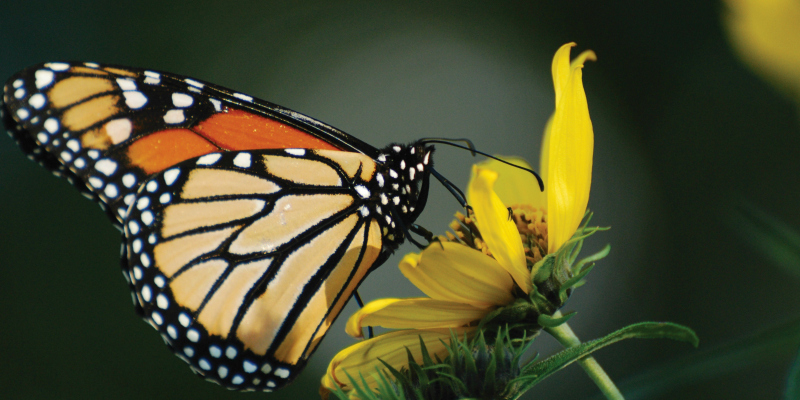By Katy Macek | Photo courtesy Joshua Mayer
If you live in Wisconsin, chances are you’ve seen a monarch butterfly or two flitting about come summertime. Perhaps you’ve also noticed those sightings aren’t as frequent as they used to be.
Though the monarch butterfly may be small, it is mighty, and its presence in Wisconsin can serve as a reminder of our role in protecting the natural environment.
“People remember seeing tons of monarchs as a kid and now hardly see any in the summer,” says Brenna Jones, coordinator of the state Department of Natural Resources’ new endeavor, the Wisconsin Monarch Collaborative.
Jones and several other women around Madison and the state are key players in the collaborative. The initiative was designed to integrate things already being done in communities to create habitats and track monarch data, says Jones. “This is all voluntary actions that people can take—we really want to make this a fun and exciting initiative anyone can help out with, even if you have a little balcony in an urban area or if you have acres of land in a more rural area,” Jones says. “The underlying piece is that together we are greater than the sum of our parts.”
Monarchs winter in Mexico and migrate 3,000 miles to North America in the spring to breed. Their caterpillars eat only milkweed, which was once plentiful along American roadsides and around farm fields. But milkweed habitat destruction and the use of pesticides has caused monarch populations to plum- met by some 80% in the last 20 years.
To help bring it back from the brink, the 70 partners in the Monarch Collaborative, from nonprofits to state agencies, hope to encourage Wisconsinites to save and plant additional milkweed in public and private places, and to encourage citizens to help track the iconic butterfly.
“What we wanted to do was build a network of stakeholders who are all interested or are already working on monarch conservation,” Jones says. “(On a statewide level) this is the first of its kind in Wisconsin.”
While work is being done on an official level, she adds that a lot of what they’re aiming for is to encourage people to create monarch habitats in their own out- door spaces, whatever those may be. Via its website, wimonarchs.org, people can also learn how to create their own monarch habitats and where they can upload their own data, everything from when they see their first monarch butterfly in the spring to keeping count of chrysalises and caterpillars, plus much more.
The collaborative also focuses on innovative ways to create monarch habitats, such as working with the state Department of Transportation to plant milkweed in rights-of-way and among other roadside greenery.
Collaborative member Karen Oberhauser, current director of the UW-Arboretum, has been researching monarchs for more than 30 years. She describes them as a “flagship” species, one that is well-known and a reminder of natural beauty. Preserving monarchs can increase the likelihood that other pollinators like birds and bees will survive as well.
Another reason to save the monarch? From a selfish perspective, Oberhauser says such vulnerable species are also indicators of humans’ ability to survive in this environment.
“If the world changes so much that it no longer supports monarchs, it’s likely going to affect the ways we live on this planet,” she says.
Learn how to help monarchs and other creatures through citizen science in our August issue. And check out bravamagazine.com for ways you can help monarchs today.



